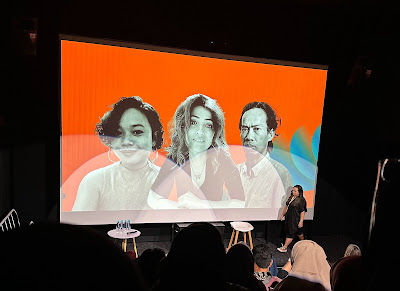Indonesian Publishing Scene: An Overview
*Ditulis untuk publikasi di majalah Publishing Perspectives atas permintaan editornya, Edward Nawotka.
Two
years ago when The Lost Symbol, a thriller novel by Dan Brown,
created a booming in US and UK book market, the same thing happened in
Indonesia in its own smaller scale. Indonesian translation of this book was
released three months after the English edition and heavily promoted by the
publisher, making it a best-selling book of the year 2010. In the same year
Indonesian reader also feasted with the publication of the Millenium Trilogy, Twilight Saga, and books by
Malcolm Gladwell.
Although
foreign bestselling titles do not always became bestselling here too,
Indonesian publishers followed international book trend closely. We can easily
find Indonesian edition of world bestselling titles displayed prominently in
book stores in main cities across the country. The genre covered generously
from mainstream novels, romance, historical, fantasy, and also non-fiction like
health, business, motivational and more. Competition is high among publishers
to acquire translation rights, that some time the offer is unusually high for
some most wanted titles.
However,
recently the trend shift slightly as more and more books by domestic authors
gains popularity. Among last month’s top ten titles in Gramedia, the biggest
chain bookstore in Indonesia, there was only one translated title. This is not
the first time to happen. “Books by local authors are more likely to sell
better than translation now,” said one sales person in Gramedia.
The
trend toward local works has begun to grow slowly since the publication of the
first book by Andrea Hirata, Laskar
Pelangi (Rainbow Troops) in 2005, which is a mega
bestseller with nearly more than half a million copies sold. Inspired by the type of story
Andrea has written--about his childhood’s struggle for education--more and more
local authors confidently send their works to publishers, get published, and
more importantly, get into the best-seller status.
Another
milestone in local trend is the publication of books by Raditya Dika, a
blogger, with his first book coming in 2006, Kambing
Jantan. This book is highly popular, sold more than 100,000 copies and has
been adapted into a movie. Bloggers get enormous attention from publishers
since then. Many more blogs turned into book. The latest one from this author
is Manusia Salmon (The Salmon Man), published
this year, which also reached a phenomenal sales number.
The
appetite for books in this country is considerably low. The number of titles
published each year is miniscule in comparison with the number of its large
population. Indonesian Publishers Association (IKAPI) estimates their 600s
members produced approximately only 13,000 new titles each year, with number of
copies sold around 41 million last year. Most of the publishers are in Java
Island, so there is also a problem of maintaining a supply chain over the
scattering islands in this archipelago, which may also be the caused of low
market penetration, among many others.
For
many low income populations, books are still a luxury item. So, middle class is
the main book-buyer in this country with population of 248 million people
because they are best able to afford books. And, the rapidly rising middle
class has now reached a number of 50 million household, creates a great
opportunity for book consumption. As the middle class grows, there will also a
growing need for books of all kinds.
However,
publishers and booksellers still have to work hard to promote reading and
book-buying habit. A chain bookstore owner, Johan Budi-Sava, once expressed his
surprise at how people say book is too expensive while at the same time they
easily spend the same amount of money to buy food at McDonald’s or PizzaHut.
His chain bookstore, Togamas, is now growing to become a good sparring-partner
for the long time player Gramedia.
Readers
usually wait for book fairs to buy books. Three book fairs hold annually in
Jakarta (Islamic Book Fair, Jakarta Book Fair and Indonesia Book Fair), and
once or twice a year in some other cities. Book fairs in Indonesia are mainly
for hard sales activities, in which publishers open stalls to sell back-list
titles with heavily discounted price. This creates some uneasy relationship
with bookstores. Togamas offers an all-time discount prices to every new book they
sell, range variously from 10 to 25 percent of publisher’s retail price.
Many
publishers are now actively involved in foreign rights acquisition. Since last
year, Indonesian Publisher Association has also open Rights Center for trading
rights in Indonesia Book Fair every November in Jakarta, to encourage domestic
publishers to sell and buy rights with foreign publishers. Participants are
mostly publishers from the neighboring Southeast Asian country, Iran, and, for
the first time this year, Korea.
It
can be said that copyrights piracy which once gave a bad name to Indonesia book
publishing industry has now been left behind in general trade book. But
government still needs to pay a great effort to eradicate piracy which still
happens in some informal photocopy kiosks near big universities, mainly for
academic books.
Piracy
is also an issue that caused publishers’ slow and reluctant approach to digital
publishing. But some new players of start-ups have begun to take steps into
publishing eBook, and big names in Indonesian publishing like Gramedia Pustaka
Utama and Mizan Publishers have also produced digital version of some of their
back-list titles. No report of sales generated to make any conclusion of their
progress yet. Despite all that, publishing scene in this country is vibrant and
growing. The largest potential right now is the children and teenage market.
With population growth rate of 1.4% and more than half of population under the
age of 40, they are indeed a promising emerging market.



Komentar
Posting Komentar